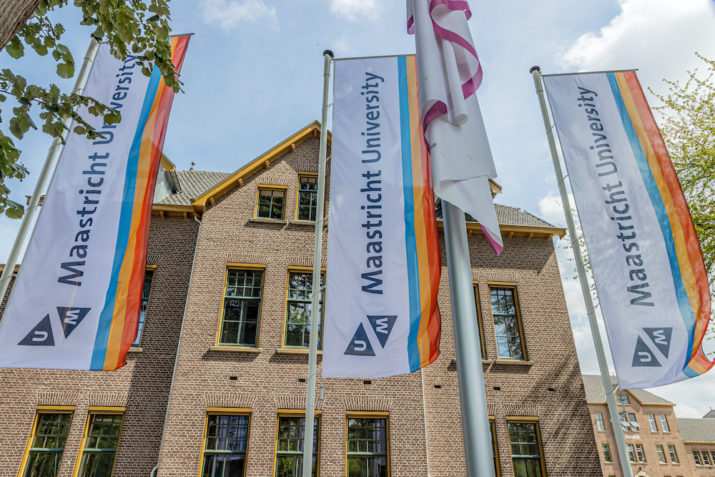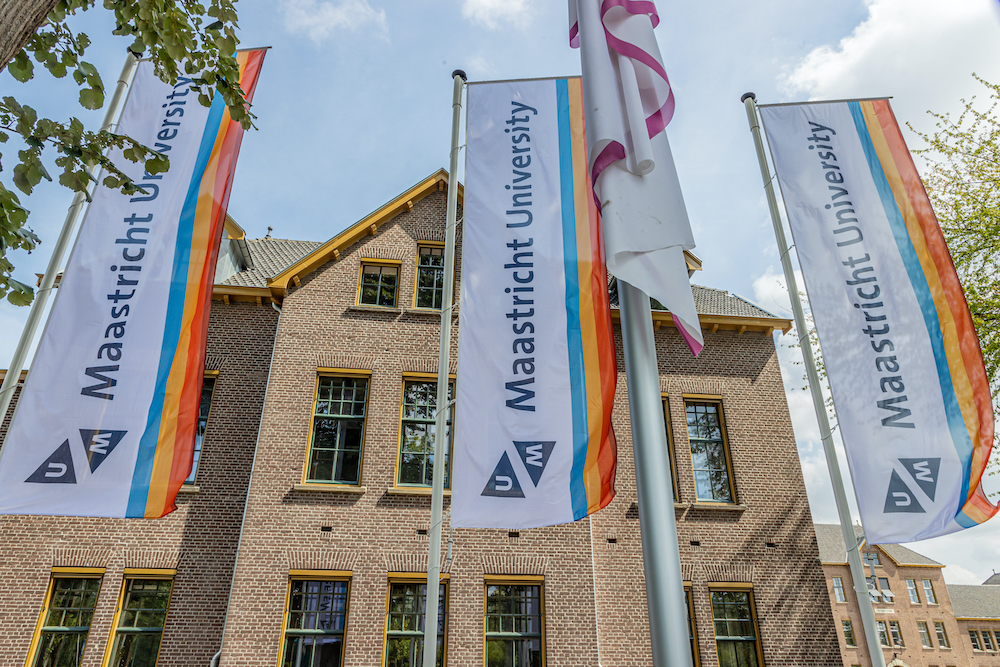
Indirect Interventions: Teaching at the Intersection of Problem Based Learning and Skills Courses

This is part of our Campus Spotlight on Maastricht University.
Maastricht University (UM) is well-known for its Problem Based Learning (PBL) education system. Another feature that stands out in the European studies bachelor program is an elaborate skills training trajectory. These two key features originally caught my attention as a teacher who believes in recognizing and encouraging the inherent capacities of students rather than treating them as mere recipients of knowledge. The PBL system is strongly student-led, yet there is always a tutor to help guide students in the learning process. As a teaching-only member of staff, this is my primary role at the faculty. The combination of skills development and PBL works well, particularly in a course called Negotiation Skills. However, finding a balance as a tutor between allowing students’ independence to flourish, and intervening to manage the group’s learning and dynamics in a course that can spotlight sensitive issues of individual performance, is a continuous challenge. I attempt to find balance through minimal direct interventions into the group’s process.
Problem Based Learning
PBL follows four core principles: it is constructive, contextual, collaborative, and self-directed (Dolmans et al. 2005, 732-733). Constructive means that students should engage in knowledge scaffolding, activating previous knowledge and building on it in order to better understand and remember new knowledge. Contextual means that knowledge is “anchored” in meaningful contexts and real-world problems, which are revisited and examined from multiple angles; this principle is an easy bedfellow with UM’s broader focus on interdisciplinary approaches. Collaborative learning does not mean task division but shared responsibility and open interaction to achieve mutual understanding of a problem and reach the common goal of agreement on potential solutions. Finally, self-directed learning “implies that learners play an active role in planning, moderating, and evaluating the learning process” (Dolmans et al. 2005, 733).
While the format of PBL is highly adaptable, it essentially has three stages: a pre-discussion as a group, a period of individual self-study for students, and a post-discussion again in plenary. In the most common form of PBL, students are presented with a prompt (a text describing a situation) in the pre-discussion, which we call an “assignment.” After reading it, they brainstorm and discuss, and ultimately decide as a group what problem needs to be addressed. They also develop a set of questions, called learning goals or learning objectives, which they aim to answer during the period of self-study and discuss as a group in the post-discussion, the latter taking place during the first part of the following group meeting. After the post-discussion, there is a moment for group reflection on the learning process for that assignment. The PBL cycle is then complete. In the second part of the session, the next assignment begins with a new pre-discussion.
Example of an assignment in Problem Based Learning (PBL): Politics on the move
The assignment initiates the first stage of the PBL cycle. It usually consists of visuals (not represented here) and a short text, but other formats are possible. Assignments often have mandatory readings or a selection of suggested readings in which students can find answers to their learning objectives, but students can—and are encouraged to—use other quality sources as well.
Here is a sample assignment:
A Minneapolis police officer killed George Floyd by kneeling on his neck for eight minutes and forty-six seconds. Following this latest case of police brutality against African-Americans, there was an outburst of demonstrations, and the #BlackLivesMatter movement returned to the headlines. Around the world, people are fed up with the systemic racism and inequality that the Black population endures. Yet this systemic racism is not new, and neither are the protests. While the Civil Rights Movement in the 1950s and 1960s in principle succeeded in ending legalized racial discrimination in the United States, the history of injustices experienced by African-Americans continues.
#BlackLivesMatter originated on social media but also spurred real-life demonstrations, perhaps most widely in 2020, with protests occurring from Tokyo to Amsterdam, across the United States, and south to Rio de Janeiro. Protests are often expected to be violent riots, but most have been peaceful. In the online world, the strategic use of social media includes the sharing of posts, including videos of police brutality, but may also include many other activities. Protesters raised their voices in Europe as well, for example, against oppressive cultural traditions, such as Zwarte Piet in the Netherlands, or heritage like the statue of King Leopold in Belgium. Among the aims of these actions is simply to empathize with the movement, but also to identify with the issues and even achieve substantial institutional changes.
The issues surrounding these demonstrations are perhaps particularly unsettling because they persist in our apparently advanced democracies, where representation and equality are claimed to be core values. Despite the efforts of long-standing interest groups, White people are both more present in politics and are more represented in terms of interests. The protests and the Black Lives Matter movement manifest a will to erase this inequality. Whether and how such social movements and interest groups will eventually achieve change remains to be seen.
Suggested starting points for reading:
- Blings, S. (2018). Niche Parties and Social Movements: Mechanisms of Programmatic Alignment and Party Success. Government and Opposition, 55(2), 220-240. https://doi.org/10.1017/gov.2018.18
- Brunsting, S., & Postmes, T. (2002). Social Movement Participation in the Digital Age: Predicting Offline and Online Collective Action. Small Group Research, 33(5), 525-554. https://doi.org/10.1177%2F104649602237169
- Clayton, D. M. (2018). Black Lives Matter and the Civil Rights Movement: A Comparative Analysis of Two Social Movements in the United States. Journal of Black Studies, 49(5), 448-480. https://doi.org/10.1177%2F0021934718764099
- Erne, R. (2017). Interest groups. In D. Caramani (Ed.), Comparative Politics (4th ed., pp. 245-259). Oxford University Press.
- Kriesi, H. (2017). Social movements. In D. Caramani (Ed.), Comparative Politics (4th ed., pp. 274-290). Oxford University Press.
- Ruzza, C. (2011). Social Movements and the European Interest Intermediation of Public Interest Groups. Journal of European Integration, 33(4), 453-469. https://doi.org/10.1080/07036337.2011.579750
- Saward, M. (2006). The Representative Claim. Contemporary Political Theory, 5(3), 297-318. https://doi.org/10.1057/palgrave.cpt.9300234
Students do not receive any particular instructions, since when they begin studying at UM, they are trained in PBL and learn to direct the process themselves. It is up to the group to decide what they think the important issue(s) are in each assignment. The text serves as the basis for discussing broader topics, which students identify through group discussion. In this example, they will very likely discuss Black Lives Matter, but also other issues, such as what defines a social movement versus a protest or an interest group, the right to protest (possibly versus public safety, especially in Corona times), the effectiveness of social movements, links between movements and political parties or interest groups, etc. There are, of course, topics students should cover in some way, so eliciting these is part of designing good assignments.
Negotiation skills: Overview, aims, structure, and assessment
Negotiation Skills (EUS2504) is a course that aims at empowering students with the basic concepts of negotiation theory and with an understanding of the typical settings of negotiations in the EU, while also providing students with experience in engaging in multilateral negotiations on meaningful policy issues. This course is part of an extensive research and skills training trajectory in the BA in European Studies. Students consistently build up their research skills throughout their bachelor’s program and apply them when conducting original research in their thesis. Language and professional skills are also stressed. The negotiation skills training course explicitly emphasizes competences that are vital in any professional and international environment, and that students will likely employ in their future careers. As such, the assignments and assessment focus on the professional quality of students’ performance, rather than purely on their academic skills.
Learning both content and skills, by the end of the course, students should 1) achieve a basic understanding of negotiation and negotiation theories, including different negotiating positions and basic game theory concepts; 2) improve their negotiation skills by applying these concepts in professional simulations and devising strategies based on a given mandate; and 3) achieve a better understanding of EU decision-making at sub-systemic, systemic, and super-systemic levels of policymaking, involving actors across different levels and policy areas.
This particular skills course is exemplary of the four PBL principles. In terms of constructive learning, this course links directly to previous and parallel content courses by providing students with a practical perspective on negotiations and decision-making, specifically in EU settings. It provides students with opportunities to experience how concepts such as the “Community method” differ from the intergovernmental mode of decision-making, or how a bargaining or problem-solving approach defines negotiations in the EU. The use of real topics at different levels of EU negotiations, such as vehicle emission regulations, missions under the Common Foreign and Security Policy (CFSP), and European Council statements―for example, reacting to the situation in Crimea―make the course explicitly contextual. The course is also clearly collaborative, as the inherent goal of each simulation is to achieve a mutually agreed upon text. In addition to predominantly self-directed meetings, there is also a considerable amount of self-study involved, as students are expected to conduct their own research on the topic under negotiation.
The course structure includes three components: lectures, tutorial group meetings, and simulations. Lectures cover basic concepts of negotiating, basic principles of game theory applied to understanding EU negotiators’ behavior, different types of negotiations and negotiators, and the practical skills of good negotiators, such as common tactics and ways to enforce influence in various negotiation settings. For each tutorial, students discuss assigned readings alongside their experiences in the previous simulations, for example about the power of the chair in formal negotiations, or the images of “hard bargaining” versus finding consensus in various EU institutions. In tutorials, it is also important to make sure everyone is on the same page about the content of the following session—the next simulation. At the end of the tutorial meeting, each student receives a mandate that must not be shared with anyone, as it will form the basis for his or her negotiation strategy―a written assignment that must be prepared for each simulation and submitted prior to the day the simulation takes place. Each mandate broadly outlines the preferences of a member state or an institutional role, such as the Council Presidency or the High Representative, which each student represents individually. Simulations last three hours, during which students must stay in character as their allocated member state or institutional representative and attempt to agree on the text under question, such as potential legislation or a press statement.
Students are assessed on their performance in the negotiation simulations as well as on their written strategies. Performance in simulations is based on six criteria: formal interventions, informal negotiations, the use of diplomatic language, contributing to a positive and constructive atmosphere even when representing a difficult position, strategy, and the accuracy of the representation of the country or institution. The written output consist of four elements. For students representing member states, these are: an opening speech, a discussion of their “best alternative to a negotiated agreement” or “BATNA,” their negotiating positions, and their negotiation strategy. Students representing an institution must produce an opening speech, foster a proper atmosphere, demonstrate negotiation management skills, and discuss the elements required to be a good chair.
Teaching negotiation skills
Group dynamics are at the core of PBL classrooms, and the group foremost encompasses the students. They are largely self-directed and left to their own devices as much as possible throughout tutorials and negotiations, but the tutor is also part of the dynamic and intervenes if necessary. Group dynamics can come under particular stress in the Negotiation Skills course, given the long sessions and students’ reliance on each other to more explicitly solve the problem, i.e. come to an agreement on the negotiated topic and text. Tutors hold two general roles in PBL: they stimulate the learning process and help manage group dynamics by establishing and maintaining a collaborative working atmosphere (Moust, Bouhuijs, and Schmidt 2007, 64).
Simulations
Tutors intervene in simulations as little as possible. This is especially important, as even when students are stuck, it is part of the development of their negotiating competences that they first try to extricate themselves from the rut on their own. Moreover, the formal structure of the negotiation simulations limits the interventions a tutor can perform without breaking character. Nonetheless, within this formal setting, subtle, indirect interventions are also possible. Playing the role of the secretariat, I can pass brief notes to the chair, for instance suggesting a break or bringing attention to a point of misunderstood wording. The chair can then choose the appropriate moment to act on such notes – or not. As the secretariat, I also keep track of the speaking order, which I sometimes slightly modify in order to prioritize those students who have not had as much speaking time. All students have a nameplate showing their role, and they set it in a vertical position when they wish to have the floor. When they are done speaking, they position it horizontally again. Several such movements can happen in a flurry, and sometimes students hesitate, letting their hands linger on their nameplates as they contemplate whether they want to speak or not. During this peculiar dance of the nameplates, I can also silently make eye contact to check with students whether they want to speak or encourage them to do so.
Occasionally, more direct interventions are necessary. This occurs when, for instance, the group has been stuck for too long on a single point, moves only in circles, or moves forward on the basis of a misunderstanding. In one case, a few students became frustrated as they felt that the negotiations dwelled on repetitive wording rather than the actual substantive content. Although they were given time to try to shift the discussion on their own, frustration began to spread among the group. To prevent a severe derailment of the negotiations, I broke character and clearly specified the problem for them. Usually this is sufficient for them to take back the initiative in resolving the problem, but in this case, the group was rather split. I suggested they could come back to the article later or give themselves a time limit to resolve the wording. Several students still felt they needed to settle the wording first, so I asked the group to identify the key elements they wanted to include. Subsequently, they were able to quickly come up with a simplified wording of the article.
Tutorials and readings
While lectures provide input and the simulations are part of the output, the tutorials serve as a key intermediate stage where ideas are discussed and where strategic elements can be developed and practiced before being integrated into the assignments or applied in the simulations. Partner work with mini mandates and a single statement, for example, help students develop ideal, realistic, and bottom-line positions. Tutorials also function well as further opportunities to evaluate previous simulations. After three hours of negotiating, students’ observations are fresh, but fatigue makes the group’s capacity for in-depth reflection somewhat limited. Further discussion of the events of the simulation in the subsequent tutorial is therefore helpful to achieve a better understanding of the connection between theory and practice.
Inevitably, when discussing completed simulations, students must address each other’s performance. In many cases, this can be quite sensitive. As students take this course in their second year, most are used to PBL and thus fairly open and respectful in their interactions and comments about their peers. However, the perception of personal responsibility for each individual’s positions in simulations can lead some students to be harsh in their critique of others or, more frequently, be unwilling to openly comment negatively on others’ performances. One common situation is when an expected ally is either absent or not as supportive as anticipated―for example, in a recent simulation, the student representing Greece was expecting much more backing from the student representing Italy on a particular aspect of migration policy. This is an important situation with which students must learn to cope. Discussing it is thus crucial in terms of understanding how to adapt one’s negotiating strategy. There are a few options for bringing this difficult topic to the floor.
Keeping with the example above, if Greece seemed unwilling to bring up the lack of support from Italy, I could ask the group if they observed any situation where support seemed lacking, or if there were situations or alignments or positions that surprised them. This way, the students who were directly involved would not have to bring it up first. Alternatively, I could state what I observed in my non-partisan role, and ask the group if my understanding of what happened is accurate. If they agree it is, I could ask them to expand on the situation, and if they disagree, I could ask them to explain how they saw or experienced the situation. Usually, this is enough to get the students directly involved (Greece and Italy) talking, but if not, I could gently and directly question them, for instance asking why Italy took position x on article y. It would be helpful to have Greece explain how the lack of Italian support affected their position, strategy, and confidence in the negotiations. This could bring the topic forward by focusing on that student’s particular experience without necessarily critiquing the student representing Italy.
While I cannot move around the room in the formal setting of the simulations, in regular tutorial meetings, I usually do so outside the circle in which the group sits. This ensures that the group owns the process and provides better opportunities for non-verbal encouragement or monitoring of students. For example, in a recent class I taught, even when a student was not that vocal in the simulation, I drew attention to that person by standing nearby, or by looking in that direction to encourage that student to contribute observations, or I signaled other students to think about that person’s role or ask them questions. This was appropriate as there were two distinct camps in the negotiations and there was qualified majority voting. Then, smaller member states, or states with a relatively neutral position on the issue at hand, became tipping points, and the perspectives of students representing these states were particularly worthwhile to hear.
Group dynamics are key to the learning process in any PBL environment, but may require particular management in Negotiation Skills. This poses a challenge for a tutor because opportunities to manage the group may be limited, especially during the simulations when direct interventions risk undermining the development of students’ negotiating skills, as well as the atmosphere of the negotiations. Moreover, as far as possible, in both the simulations and tutorials, the self-directed element of PBL is paramount. Keeping in mind the tutor’s two main roles―to stimulate the learning process and to help establish and maintain a collaborative working atmosphere―finding indirect ways to intervene and support the group is how I approach this ongoing challenge.
A set of readings supports the different topics discussed in tutorials.
Tutorial 1: Best Alternative to a Negotiated Agreement (BATNA), positions, and making concessions
Readings:
- Fisher, R., Ury, W. L., and Patton, B. 2011. “What if they are more powerful?” In Getting to yes: Negotiating agreement without giving in (2nd Edition), 97-106. New York: Penguin.
- Harvard Law School. 2012. BATNA Basics: Boost Your Power at the Bargaining Table. Negotiation Management Report 10.
- Malhotra, D. 2006. Four Strategies for Making Concessions. Unpublished paper, Harvard Business School.
- Simulation I “CO2 emissions”. Please read carefully Annex 1 of the course manual.
Recommended Readings:
- Arunachalam, V., Dilla, W., Shelley, M., and Chan, C. 1998. “Market alternatives, third party intervention, and third party informedness in negotiation.” Group Decision and Negotiation 7 (2): 81-107.
- Buelens, M. and van Poucke, D. 2004. “Determinants of a negotiator’s initial opening offer.” Journal of Business and Psychology 19 (1): 23-35.
- Pinkley, R. L., Neale, M. A., and Bennett, R. J. 1994. “The impact of alternatives to settlement in dyadic negotiation.” Organizational Behavior and Human Decision Processes 57 (1): 97-116.
Tutorial 2: EU Negotiations – the shadow of the vote, and the power of the chair
Readings:
- Heisenberg, D. 2005. “The institution of ‘consensus’ in the European Union: Formal versus informal decision‐making in the Council.” European Journal of Political Research 44 (1): 65-90.
- Tallberg, J. 2004. “The power of the presidency: Brokerage, efficiency and distribution in EU negotiations.” Journal of Common Market Studies 42 (5): 999-1022.
- Simulation II “NAVFOR MED”. Please read carefully Annex 2 of the course manual.
Tutorial 3: EU Negotiations – problem solving and European Council bargaining
Readings:
- Lewis, J. 1998. “Is the ‘hard bargaining’ image of the Council misleading? The Committee of Permanent Representatives and the local elections directive.” Journal of Common Market Studies 36 (4): 479-504.
- Tallberg, J. 2008. “Bargaining power in the European Council.” Journal of Common Market Studies 46 (3): 685-708.
Recommended Reading:
- Dür, A., and Mateo, G. 2010. “Bargaining power and negotiation tactics: The negotiations on the EU’s financial perspective, 2007–13.” Journal of Common Market Studies 48 (3): 557-578.
The principles of PBL—constructive, contextual, collaborative, and self-directed learning—are respected in a highly practical manner in the Negotiation Skills course. Practicality is a significant part of what makes the course popular. Based on in-person and online feedback, we know that students appreciate role-playing, applying the knowledge they acquired in previous courses, engaging in the readings, and conducting independent research. Oftentimes, students who are less inclined towards academic writing also come into their own with excellent performances in the simulations.
Marisa Mori (MSc Political Science) is a Teacher/Lecturer based in the Department of Politics at Maastricht University. She teaches various courses throughout the three-year BA in European Studies, having previously taught English in Taiwan. When not focused on education and teaching delivery, she researches issues of security in the trilateral EU-China-Africa relationship.
References:
Dolmans, Diana H. J. M., De Grave, Willem, Wolfhagen, Ineke H. A. P., and van der Vleuten, Cees, P. M. 2005. “Problem-based learning: future challenges for educational practice and research.” Medical Education 39 (7): 732-741. doi:10.1111/j.1365-2929.2005.02205.x.
Moust, Jos H. C., Bouhuijs, Peter A. J., and Schmidt, Henk G. 2007. Introduction to Problem-based Learning: A Guide for Students. Groningen: Noordhoff Uitgevers.
Published on November 10, 2020.




